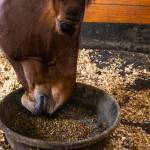Question
I own a 12-year-old Paint mare that I rescued last June. At the time, she was very skinny. She had gained considerable weight by December but then had an episode of laminitis. Now it’s May and she’s fat. We know she needs to lose weight, for the health of her feet specifically, as well as her overall well-being. We have begun a weight-loss program: she’s fed four flakes of hay when she’s in the barn (8 hours per day), pasture (reduced through the use of a muzzle), and a metabolic micronutrient supplement. She’s too high-strung for us to ride. What else can we do?
Answer
Based on the information you provided, it sounds like you are on the right track by limiting her grass intake with the muzzle and offering a micronutrient supplement instead of feed. Weight loss takes time, so if you’ve only just started using the muzzle, expect a difference in a month or two. Exercise is another important component of weight loss.
You didn’t mention what type of hay she is offered when she is stalled, but I assume it is some kind of grass hay. Because she doesn’t need extra calories, even a low-quality hay would be acceptable for her to munch on while inside. By low-quality, I mean it might have been baled after the optimal time so it is a bit overmature or it might be a little more yellowish-green than bright green; never feed her dusty, weedy, extremely stemmy, or moldy hay. I wouldn’t offer her more than one or two flakes while stalled. To make the smaller amount of hay last longer, which keeps the gastrointestinal tract healthier, you can use a slow-feed haynet (these generally have much smaller holes in them than traditional nets) to reduce her consumption.
Overweight horses prone to metabolic problems are ideal candidates for EquiShure, a product developed by Kentucky Equine Research (KER). Spring grass can lead to large amounts of rapidly fermentable carbohydrates entering the hindgut, resulting in excessive gas production, a drop in hindgut pH, and loose manure. EquiShure is a time-released hindgut buffer that includes active ingredients designed to stabilize the pH of the hindgut, helping to prevent laminitis.
If possible, you may want to use a weight tape to track the mare’s weight every two weeks or so. If the grass diminishes in mid to late summer, as so often happens, you may need to increase her forage intake. You can do this in several ways:
- If she’s cleaning up all of the low-quality hay when stalled, you could add more of the same hay.
- Increase the quality of hay a bit (e.g., choose a better quality grass hay which, in turn, will have more calories in it) but feed about the same amount.
- Allow her to graze an hour or two without her muzzle, especially if there is a paddock or pasture available that is a bit eaten down.
Depending on her metabolism, she may not feel the effects of a slowdown in grass growth. Until then, implement the diet changes outlined here, and see if you can find a way to exercise her. Although you cannot ride her, if long-lining or longeing (either free longeing or more structured work) is possible, I recommend adding that to her daily routine. Near-daily exercise will not only help with weight loss, but it will also help keep metabolic problems from taking hold. As little as 30 minutes of exercise six or seven days a week is thought to prevent metabolic issues. Exercise will, of course, depend largely on her soundness. If there is any question about her soundness because of the laminitis, she should be evaluated by a veterinarian before an exercise schedule is put into play.








